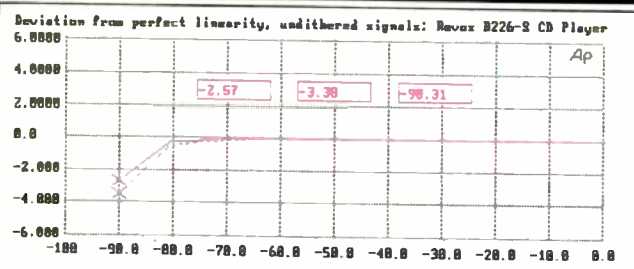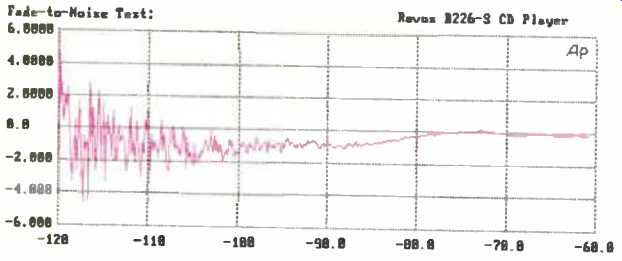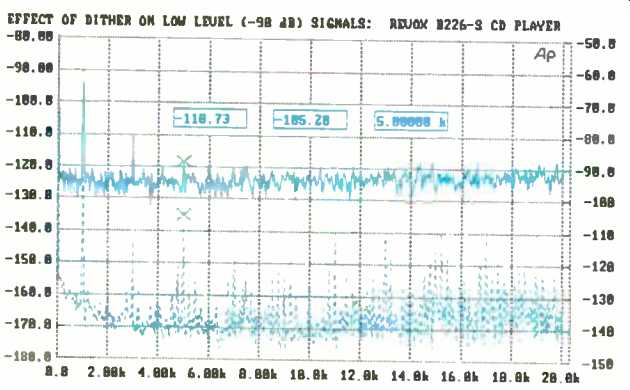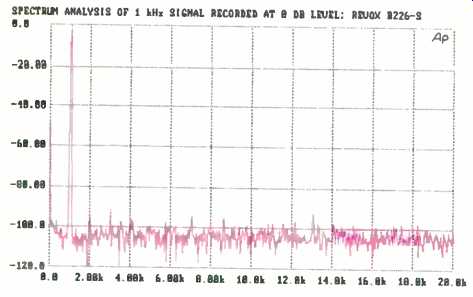
Manufacturer's Specifications:
Frequency Response: 20 Hz to 20 kHz, ±0.1 dB.
THD: 0.004%, 20 Hz to 20 kHz.
S/N: Unweighted, 102 dB; A-weighted, 108 dB.
Separation: Greater than 90 dB, 20 Hz to 20 kHz.
Output Level: Fixed, 2.5 V; variable, 0 to 2.5 V; digital, 0.5 V peak to peak; headphones, 4.5 V peak to peak.
Channel Balance: Greater than 0.2 dB.
Search Time: Less than 3 S for any CD location.
Number of Program Steps: 19, set by disc time, track number, or user set markers.
Remote Control: Optional, via Revox B208 hand-held remote ($160), B210 table-top remote ($995), B207 infrared transmitter ($350), or B200 S controller ($1,295).
Power Requirements: 120 V a.c., 60 Hz, 25 watts.
Dimensions: 18 7/8 in. W x 4 3/8 in. H x 13 in. D (48 cm x 11.8 cm x 33.2 cm).
Weight: 20.9 lbs. (9.5 kg).
Price: $1,895.
Company Address: 1425 Elm Hill Pike, Nashville, Tenn. 37210, USA.
Have you ever wondered why some CD players cost well under $200 while others sell for up to $2,000 and more? The Revox B226-S provides some of the answers, both in terms of its convenience features and its sonic and measured performance. The B226-S CD player features 16-bit, four times oversampling, proving that such late innovations as eight-times oversampling, 16-times oversampling, or even 64-times oversampling and 1-bit D/A conversion are not the only ways in which proper D/A retrieval may be accomplished. This player is part of Revox's new 200-S series of audio components. Happily, with these components, Revox has finally abandoned the rather bulky look and the two-tone gray color scheme of its earlier units. The 200-S series is distinguished by elegant, low-profile styling, an attractive black and gold color scheme, and glossy black-lacquered side panels.
The B226-S has a newly designed transport built on a precision-tooled aluminum die-cast plate and a new D/A converter used in the Studer professional CD players. As you might expect from a player in this price category, there's a direct digital output, should you choose to feed digital audio data to a separate D/A converter. The player can be programmed with up to 19 selections for playback in any sequence. Additionally, you can program this unit to play several tracks in the order in which they appear on the disc, using up only one of the 19 program slots in doing so.
Sections of a specific selection can be "marked," and such sections also can be intermixed in the programming. You can even program in a pause at any step in the programming sequence, and if you wish, you can program the unit to shut itself off (with the player in the standby mode) at the end of your programming steps. Among the convenience features are variable headphone output, variable outputs for feeding a power amplifier or a powered speaker system directly, and standard fixed-level outputs.
The die-cast, drive-mechanism chassis is mounted on a damped suspension for resonance-free operation. According to Revox, this also lessens the dependence on error correction circuitry.
Control Layout
The front panel is divided into main and auxiliary keypads, with an electroluminescent display centered beneath the disc tray. Main controls at the right side of the panel include a "Power" switch, a "Load" button that opens and closes the disc tray, a "Pause" button, an "Index" advance button for those discs that have index points within tracks, and a large button labeled "Play/Next" to initiate play and to advance to the next track during play.
Numeric keys at the upper left of the panel are used for direct access to any track, from 1 to a theoretical maximum of 99. These numbered keys are also used during track programming and for programming time segments.
Auxiliary keys are found along the lower right and lower left of the front panel. The controls at the lower right include keys for scanning up and down (output level drops 12 dB during scan) and for raising and lowering volume at the variable line or headphone outputs. Other keys in this area are for "Display" (selecting elapsed or remaining disc or track time), "Autostop" (which puts the player in pause mode alter the current selection), "Locate" (which puts the player in pause mode at the start of the current track), and "Stop." A stereo headphone jack is at the panel's lower right corner.
At the lower left of the panel are additional auxiliary keys for the various types of programming that can be done with the B226-S. These include a "Program" key, a "Cursor" key to access any position on the display for editing, "Program Step" keys for paging backwards or forwards through a program, a "Mark" key for identifying segments during programming, a "Store" key, a "Loop" key for continuous replay of a disc or a program sequence, and a "Track/Time" key that switches between track and time indications during programming.
The central display shows program step number; track and index numbers; the various playing time indications; "Pause," "Autostop," and "Loop" indications (when these functions have been activated), and a graphic indication of volume settings when the headphone or the variable line output level is being adjusted.
The rear panel has pairs of fixed- and variable-level output jacks, two digital coaxial output jacks wired in parallel (there is no optical output), and a multi-pin socket for Revox's multi-room Easy-line infrared control system. Revox offers a 55-function hand-held remote, the B208, and a new table-top remote, the B210, both of which can be used with the Easy-line system and other Revox components. The B210 can learn the infrared signals of other manufacturers' products, and it is a two-way unit. If used with the B207 infrared transmitter and a B200-S controller, the B210 can receive and display status information from Revox 200-S series components. When used with the B226-S CD player, it can show virtually everything on this unit's display, including track number, time, and whether a disc is loaded or not.

Measurements
This is the first CD player I tested after my Audio Precision System One test equipment was upgraded to the digital signal processing (DSP) mode. Accordingly, you will see some graphs I have not been able to produce before. I am now able to explore the capabilities of components far beyond anything I've been able to do in the past, as I will explain when I describe some of the new graphs and acquired data.
In addition to the DSP mode and the digital domain upgrading my test system now incorporates, Audio Precision's new version of their software enables me to call out actual data values on the graphs themselves. You can see the first example of this in Fig. 1, where frequency response of the CD player is plotted. I set the cursor on the graph to about 20 kHz and was able to read directly that response was absolutely flat for the left channel and was up 0.02 dB for the right. Rarely, if ever, have I seen a CD player exhibit such response accuracy at the upper frequency limit.
Interchannel phase error was virtually nonexistent. Even at 20 kHz, the difference between channels amounted to an insignificant 0.3°. The graph of this was so close to a perfect straight line that I saw no need to present it here.
Figure 2 shows how THD + N varied as a function of frequency. At 1 kHz, THD + N measured only 0.006%. The rise in apparent THD + N at 20 kHz was caused not so much by actual harmonic distortion components as by small amounts of "beats" that were visible on a 'scope when higher frequency test signals were reproduced. In any case, even at 20 kHz, THD + N was on the order of 0.176% for either channel, as shown by the readouts in Fig. 2.
When I measured THD + N versus signal level (not shown), I got a reading of more than 84 dB below reference for a 1-kHz signal at maximum (0-dB) recorded level. (This corresponds to 0.006%, providing perfect correlation with the test shown in Fig. 2.) The reading of about 84 dB was actually the highest point on the curve: THD + N was at least 97 dB below reference at recorded levels from-90 to -60 dB, rising to 94 dB below reference at -30 dB and to about 91 dB below reference at-10 dB. To make room for a more revealing test which I can now make, I will no longer show a plot of this-except when there is something unusual about the curve. I also checked SMPTE-IM distortion, which I found to be 0.00313% for the left channel and 0.00280% for the right.
When playing the "silent" track of my CBS CD-1 test disc, I measured an A-weighted S/N ratio of 114.07 dB for the left channel and 110.88 dB for the right, as compared with Revox's claim of 108 dB. A spectral analysis of the residual noise over the audible frequency range (Fig. 3) revealed that this is one of the rare CD players that has provided virtually perfect isolation between its digital and analog audio circuitry and its power-supply circuitry. There is absolutely no "peak" in the noise level at the power-line frequency of 60 Hz or its harmonics.

Fig. 1--Frequency response. Left channel is solid curve, right channel is
dashed, here and through Fig. 5.

Fig. 2--THD + N vs. frequency at 0-dB (maximum) recorded level.

Fig. 3--Spectrum analysis of residual noise when playing "no-signal" track
of CD-1 test disc; see text.
Separation in the worst-case direction (left to right) was 98 dB at 16 kHz. The slope of the curves (which I am no longer showing) indicated that separation at 20 kHz should still be well in excess of what Revox claims. Separation was greater than 110 dB at all frequencies from about 100 Hz to 4 kHz.
As I have indicated in several of my recent evaluations of CD players, I consider low-level linearity to be an important criterion in distinguishing among the "good," "better," and "best" players currently available. Frankly, I don't care what methodology is used in D/A conversion, as long as good linearity extends all the way down to very low levels. Figure 4 is a plot of deviation from perfect linearity versus recorded level. Linearity was just about perfect down to -80 dB, but at -90 dB, it was off by -2.57 dB for the left channel and by -3.38 dB for the right. These are not the best linearity numbers I have ever obtained, but they are well above average.
Results were excellent when I used dithered test signals at low levels (70 to -100 dB). As plotted in Fig. 5, deviation from perfect linearity was off by only -1.82 dB for the left channel and -2.29 dB for the right. These results are among the best I have ever seen, as are the results obtained using the "fade-to-noise" test signals on the CD-1 test disc (Fig. 6). These signals are also dithered and extend from -60 to -120 dB. The signal is masked by the noise at a level of about -110 dB, which corresponds to the EIA dynamic range of the player. Note, too, how linearity remains accurate, within about 2 dB, all the way down to -120 dB. Dynamic range, in accordance with the EIAJ method, yielded figures of 97.06 dB for the left channel and 96.83 dB for the right. Frequency accuracy of the player's internal master clock was 0.0098%. Ever since I learned about the benefits of "dither" in recording sound digitally, I have wanted to be able to demonstrate those advantages. I have also suspected that all CD players would exhibit improvements in low-level signal reproduction if those signals were originally recorded with the proper amount and type of dither. Now, at last, with my DSP-enhanced test gear, I am able to show the effect of dither in low-level signals as well as to compare its effect from one player to the next. So, let the Revox B226-S serve as a reference player for this new test.
Using the FFT spectrum analysis capability of the test equipment, I played two tracks of the CD-1 test disc. The third index point of track 19 has a 1-kHz dithered test tone recorded at 90 dB below maximum recorded level. A spectrum analysis of this test signal, over the audible spectrum, is shown in the top curve of Fig. 7. (Refer to the left-hand decibel scale to read this plot.) Notice that the only significant harmonic component is the one that occurred at 3 kHz, the third harmonic of the 1-kHz test tone. (The test tone itself shows as a peak at exactly -90 dB.) Contrast this with the bottom curve, which was made using undithered signals at the same level. (Refer to the right-hand scale to read the bottom plot.) A large assortment of distortion components especially at the higher odd-order harmonics-are now visible, along with many other undesired spurious components throughout the audible range. The fifth harmonic's amplitude is down only 105.2 dB with the undithered signal; with the dithered signal, it is down more than 118.73 dB. Close examination reveals, however, that while adding dither decreases distortion components, it adds somewhat to the residual random noise level. Thus, ignoring the peaks in the bottom curve, average noise level seems to be hovering between -130 and 140 dB; in the case of the dithered signals, average noise ranges between -120 and -130 dB. Since the noise level will still be inaudible under normal listening conditions, this is a small price to pay for "cleaning up" the low-level signals and delivering them with greater waveform accuracy than would otherwise be possible in a 16-bit digital system.

Fig. 4-Deviation from perfect linearity for undithered signals.

Fig. 5-Deviation from perfect linearity for low-level, dithered signals.

Fig. 6-Fade-to-noise test.

Fig. 7-Spectrum analysis of signal at-90 dB with dither (top curve) and
without dither (bottom curve). Use scale at left for top curve and scale
at right for bottom. See text.

Fig. 8--Monotonicity test; see text.

Fig. 9--Spectrum analysis of signal recorded at 0 dB; see text.
In testing player monotonicity, I have had a hard time trying to interpret this complex signal (let alone trying to synchronize it) by viewing it on an oscilloscope. Now I can abandon the oscilloscope, thanks to the waveform-versus time plotting capability of the DSP FFT enhancement incorporated in my test setup. By capturing a portion of the test signal using an FFT, am able to expand the waveform display so that a single cycle of the waveform sequence may be examined in detail. That's what I've done for the display shown in Fig. 8, and if you've read my previous reports on CD players, I think you'll have to admit this new display is a lot clearer and more detailed than a 'scope photo. I'll have to reserve judgment about this player's monotonicity because, with so much detail now available, I have nothing to compare it with! My first impression would be that the monotonicity looks quite good, despite the slight displacement (about 750 µV) of the entire series of steps from the zero axis. A perfect monotonicity pattern would have successive steps increasing uniformly in both positive and negative directions.
A unit-pulse waveform showed that the B226-S does not invert signal polarity. Its square-wave response was typical of CD players with digital filtering, which virtually all quality players have nowadays. Considering the present state of CD player development, these waveforms no longer show significant differences between most units, and I am omitting them from here on.
Figure 9 is a spectrum analysis of a 1-kHz signal recorded at maximum level and reproduced by the B226-S CD player. While Fig. 2, measured using analog analysis, shows THD plus noise, doing the same analysis by means of DSP and FFT facilities yielded the results shown. Note that the most significant harmonic distortion components (third, seventh, and 13th harmonics) are between -90 and -95 dB. Taking the square root of the sum of the squares of these minute distortion components yields a net THD of about 0.0031%, as against the figure of 0.006% for THD plus noise obtained using analog measurement techniques.
Revox's claims for excellent tracking were substantiated when I played the defects tracks of my test discs, which have calibrated lengths of missing data. This player was able to track segments with full 1.5-mm data gaps. That's as high an error-correction capability as I have seen. Furthermore, tapping briskly on the top and side surfaces of this player did not cause mistracking.
Use and Listening Tests
I particularly liked the way programming is accomplished with the B226-S. The user is given a great many options, and each is thoroughly explained in the multi-lingual owner's manual, with some 33 pages each for English, French, and German. The "power off" feature at the end of a program will be appreciated by all of us who tend to nap while listening to music late at night (or during the day). Some of my recently acquired discs served as good audition material for this elegant player. Among them were a couple of new Delos releases engineered by my good friend John Eargle; these included a disc of Mozart and Beethoven Piano and Wind Quintets (D/CD-3024) and another featuring Brahms' String Quintet No. 2 and Quintet for Clarinet and Strings in B Minor (DE-3066). Both discs have several quiet passages that are very useful in assessing the clarity of low-level reproduction-something the Revox B226-S seems particularly able to deliver.
Start-up from pause was especially fast-well under 1 S. Track access was also extremely fast. No matter what track you are playing, merely push the number keys for another track, push the "Play/Next" button, and off goes the laser pickup to find and play the track of your choice. Although index selection can be done only in the forward direction, the fast scan modes accelerate as you hold down the appropriate buttons, so it doesn't take too long to backtrack one or more index points.
For me, the timing of this evaluation couldn't have been better. I wanted to put my newly enhanced Audio Precision test gear through its paces on a top-quality CD player rather than an average one. The Revox 8226-S was a perfect choice for this purpose, and if you can afford the rather steep price, it may well be the perfect choice for music lovers who appreciate good ergonomics, carefully thought-out convenience features, and most importantly, sound quality beyond reproach.
-Leonard Feldman
(Source: Audio magazine, Mar. 1990)
Also see:
Revox B225 Compact Disc Player (Sept. 1984)
Revox B215 Cassette Deck (July 1985)
= = = =